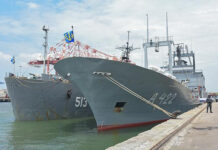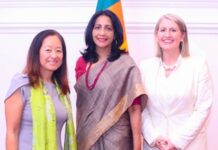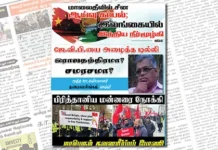Following an advisory by India last month, asking citizens to be careful about travel to Sri Lanka, monthly tourist arrivals in the Indian Ocean island nation – still pounded by severe economic headwinds – dipped by 20% in August compared to the previous month.
With the advisory issued just after a Chinese research vessel was allowed to dock at Sri Lanka’s Hambantota port, the drop in Indian tourists seems to have functioned as a quick demonstration of New Delhi’s use of economic leverage to express unhappiness over Sri Lanka’s handling of the matter.
Sri Lanka’s top tourism official was explicit in stating that the decrease was thanks to the country’s northern neighbour.
“…This happened especially in India. If you look at the Indian arrivals, they contribute a lot to the sudden drop in arrivals towards the latter part of August,” chairman of Sri Lanka Tourism Development Authority, Priyantha Fernando, told a top Sri Lankan business news portal, EconomyNext.
Indian tourists had been the largest source of income for the Sri Lankan market in the first eight months of 2022. In July, 6,031 Indian citizens travelled to Sri Lanka, which dipped to 5,340 in August.
Indians topped the list of foreign arrivals to the country even in July – a month which saw mass protests over the economy reach their climax with President Gotabaya Rajapaksa dramatically fleeing the country after the storming of the presidential palace. Prime Minister Ranil Wickremesinghe replaced him as president after getting support from ruling party members.

Chinese military survey ship Yuan Wang 5 arrives at Hambantota International Port in Hambantota, Sri Lanka, August 16, 2022. Photo: Reuters/Stringer
A month later, at the August 25 weekly briefing, the Ministry of External Affairs spokesperson Arindam Bagchi issued a statement calling on Indian citizens to consider “all relevant factors” before going on “any essential travel to Sri Lanka.”
“As regards travel of Indians to Sri Lanka in the current situation, let me emphasize that safety and well-being of Indian nationals during their stay outside India and including in Sri Lanka in this particular case is always of prime importance. Our endeavour is to prevent any untoward incidents involving Indians outside India. We would therefore encourage Indians to exercise all care and caution while in Sri Lanka. They should examine all relevant factors, including currency convertibility and the fuel situation before undertaking any essential travel to Sri Lanka. That’s for the moment that’s what I had. Look, our High Commission of course, is in touch with all local authorities. But this was a general guidance to people who are there, tourists who are there, or who are thinking of going, that would be our guidance,” Bagchi said.
The above detailed response from the spokesperson was in answer to a short question on whether India had raised with local authorities “some incident[s] jeopardizing safety of Indians in Sri Lanka” that have been “observed”.
The MEA spokesperson also stated that India has been following “these developments”, but did not give details of any such incidents.
The only recent case of assault on an Indian national in Sri Lanka – that is in the public domain – was reported to have occurred on July 18. The Indian high commission announced a day later that the director of the Indian visa centre, a private Indian citizen, had sustained “grievous injuries in an unprovoked assault” in Colombo.
After the July 18 incident, the Indian high commission tweeted advice for Indian nationals in Sri Lanka to remain “aware of latest developments and accordingly plan their movements and activities”. An article in a Sri Lankan newspaper reported speculation that the assault may have been due to rumours that India had tried to help former President Gotabaya Rajapaksa to leave the country. India had categorically denied facilitating Rajapaksa’s travel after he left for the Maldives on a military aircraft on July 13.
There have been no other public reports of any other incidents of harassment of Indian nationals, whether residents or tourists, The Wire has confirmed.
Notably, the MEA spokesperson’s advisory aimed at Indian tourists was issued more than a month later, on August 25. However, the advice for Indian travellers was sprung just a week after the Chinese ship Yuan Wang 5 docked at Hambantota port on August 16.
The signal from India for Sri Lanka was indirect, but clear.
Faced with concerns from New Delhi, Sri Lanka had first asked China to indefinitely defer the ship’s arrival. India had been suspicious about the vessel’s purpose and the timing of its arrival at the Sri Lankan port, especially since there had been no such visits in several years.
However, Colombo abruptly changed its mind and cleared Yuan Wang 5’s docking. The vessel reached the southern Sri Lankan port of Hambantota on August 16 to a red-carpet welcome led by the Chinese ambassador, and departed on schedule on August 22.
Meanwhile, this year, India has extended $4 billion in soft loans and currency swaps to keep the Sri Lankan economy afloat. At the same time, Sri Lanka has to undertake delicate negotiations with China for restructuring its debt as part of discussions with all its foreign creditors. This agreement on debt restructuring is essential before the International Monetary Fund starts to disburse its $2.9 billion loan to Colombo.
New Delhi’s annoyance was for all to see when the Indian high commission berated the Chinese envoy and claimed that his comparison of Yuan Wang 5’s docking to the latest Taiwan Strait tensions with the United States, was a “giveaway” of the strategic importance of the ship visit.
In the backdrop of the India-China spat, the August 25 advisory by the MEA spokesperson also raised eyebrows in Sri Lanka as it came just as European countries relaxed their own advisories against non-essential travel to the island nation due to the economic crisis and shortages.
The tourism industry has become a vital tool for Sri Lanka’s economic revival since the pandemic, especially considering that the country has been starved of foreign currency to import fuel and other essential commodities.
From January to the first week of August this year, India had been the largest source of tourist arrivals to Sri Lanka, contributing 76,581 visitors. Despite its earlier advisory against non-essential travel, the UK accounted for the second largest group of foreign tourists during that period. The trend changed in the second half of August, with the UK overtaking India as the top contributor of tourists to Sri Lanka.
The August daily arrival numbers published by EconomyNext showed that a slight drop had begun since the first week of the month. However, the numbers remained consistently in the low 800s and high 700s in the fourth week of August. In the last two weeks of August, tourist arrivals dipped as low as 759 per day from a high of around 1839 on August 1.
On Friday, India gave an unusually critical response at the debate on the UN High Commissioner for Human Right’s report on Sri Lanka. “In this regard, the Indian delegation notes with concern the lack of measurable progress by Government of Sri Lanka on their commitments of a political solution to the ethnic issue – through full implementation of the 13th Amendment of the Constitution, delegation of powers to Provincial Councils and holding of Provincial Council elections at the earliest,” said Indian permanent representative to the UN in Geneva, Indra Mani Pandey.
Diplomacy.





